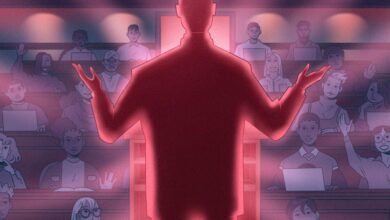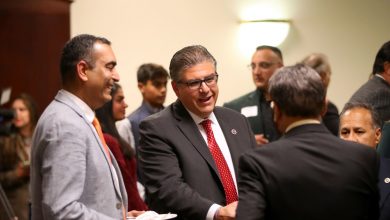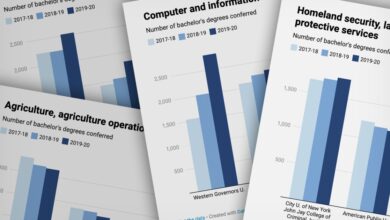Presidents Are Changing Their Tune on Free Speech

[ad_1]
College presidents know a free-speech controversy is going to burst forth on their campus if it hasn’t already. One week it’s a guest lecturer shouted down at Stanford. The next it’s a Florida bill that would restrict how campuses can teach about race in general-education courses. The next it’s a request for mandatory trigger warnings at Cornell.
While in the past a president’s response to such a controversy may have been silence or a carefully worded message, now college leaders are beginning to speak up in more forceful terms.
Here and there, in notes to campus communities, speeches during formal events, and open letters, university presidents and other administrators are pushing back in defense of academic freedom and free speech. They’re not standing on soapboxes shouting against would-be censors, but the words they choose, the battles they pick, and the signals they send suggest a renewed fondness for free-speech principles. Leaders at Stanford, Pennsylvania State, Cornell, and elsewhere, are talking bluntly about the value of the First Amendment; a group of former presidents have mobilized to protect campus speech from legislative attacks; and The Washington Post editorial board, among others in the media, is looking on with approval, describing these developments as “a welcome reminder that academic institutions have the power to defend their fundamental values — and are willing to use it.”
Those unfurling from a defensive crouch say they are doing so because they believe higher education needs the ability to explore all topics and viewpoints.
“For us, academic freedom is at the heart of what universities do,” President Martha E. Pollack of Cornell University told The Chronicle. “Without it, knowledge doesn’t advance.”
There’s a tendency to characterize the learning environment as a place where you are safe. We need to have brave spaces.
After the expected praise of the depth and brilliance of the class in her welcome speech, Pollack used the bulk of her address to tell students that the key to success at Cornell is to “engage across difference,” “develop an appreciation of the importance of free speech,” and learn how to responsibly participate in civil discourse.
“Free speech is under attack in our country, from across the political spectrum,” she said. “But free speech, as difficult and as challenging as it is, is not only the bedrock of higher education. It’s also the bedrock of democracy and a free society. Chipping away at that bedrock — even for what we think are good reasons, like protecting others — diminishes our capacity as a learning community to do our work, and it puts our democracy at risk.”
She continued: “Because if we ever accept that someone, anyone, has the right to tell us what we’re allowed to say — we’ll also be giving them the right to control what we’re allowed to hear and to know.”
Seven months later, at the end of March, those words would be put to a test. Cornell’s Student Assembly unanimously passed a resolution that proposed requiring professors to place trigger warnings in syllabi for “any traumatic content” that would be discussed, as well as excuse any student wishing to opt out of learning that material. Pollack and Provost Michael Kotlikoff rejected the resolution in early April, taking the opportunity to underline their commitment to academic freedom.
The pair wrote that the resolution “would have a chilling effect on faculty, who would naturally fear censure lest they bring a discussion spontaneously into new and challenging territory, or fail to accurately anticipate students’ reaction to a topic or idea. And it would unacceptably limit our students’ ability to speak, question, and explore, lest a classroom conversation veer into an area determined ‘off-limits’ unless warned against weeks or months earlier.”
That chilling effect would most likely pop up in dialogue in a class as a professor and students explored a topic, Pollack explained to The Chronicle. Her decision drew hosannas from those on the political right, who saw the move as a defense against “woke” students.
But it wasn’t a political move, Pollack said. “There are pressures from both ends of the political spectrum,” she said, noting the push from the right to censor what is being said and taught is more frequent and heavier, especially in attacks on diversity, equity, and inclusion programs.
It’s a balancing act to both protect students and also allow free speech, Pollack acknowledged. “It’s my job to honor both of those values,” she said. “We allow speakers but also support students who disagree with those speakers.”
That line’s not an easy one to walk.
Earlier this academic year, Stanford’s law school invited as a speaker Judge Stuart Kyle Duncan, who was appointed by former President Donald Trump to the United States Court of Appeals for the Fifth Circuit. He was met by student protesters who disrupted his speech. After Duncan asked for administrators present to intervene, an associate dean of diversity spoke up, seemingly asking Duncan if the speech was worth all the fuss and criticizing him for his stands on various positions.
A couple of days later, President Marc Tessier-Lavigne of Stanford and Jenny S. Martinez, dean of the law school, apologized to Duncan in a joint letter.
“What happened was inconsistent with our policies on free speech, and we are very sorry about the experience you had while visiting our campus,” the letter read. “We are very clear with our students that, given our commitment to free expression, if there are speakers they disagree with, they are welcome to exercise their right to protest but not to disrupt the proceedings.” Later, Martinez penned a 10-page letter elaborating on how the law school would handle free-speech issues, declaring, among other things, that the school’s “commitment to diversity, equity, and inclusion actually means that we must protect free expression of all views.”
Martinez also announced future educational programming on the topic — something leaders elsewhere have also embraced. Two weeks after rejecting the trigger-warning resolution, Pollack announced that the university will dedicate the 2023-24 academic year to free speech and academic freedom, including special events and discussions to highlight the history of academic freedom.
The goal is to help students learn to engage with different opinions, but it’s more than just that.
“Knowledge doesn’t advance unless we are able to engage all ideas, even those some don’t want explored,” Pollack said.

Ricardo Rey for the Chronicle
“Proponents of these laws attempt to justify them by repeating claims that universities are places where political correctness runs rampant and students are intolerant of alternative viewpoints. In my experience, these problems are much less pervasive than media coverage suggests, but they do exist,” wrote Christina Paxson, president of Brown University in a recent New York Times essay. “But it is ludicrous to claim that state-sponsored censorship — which carries the full force of the government and can even entail criminal penalties — is justified by student misconduct or peer pressure.”
Students are spending more time on social media and in echo chambers. They are less and less likely to engage with ideas they don’t agree with.
She added that the “ironic truth” is that such laws “are themselves attempts to indoctrinate students into seeing the world through one lens. This is exactly the opposite of what colleges and universities should do.”
While some presidents have testified against bills in their states, they’re loath to speak out publicly and risk antagonizing the holders of state purse strings.
“Too often … university and college leaders face an impossible choice: openly criticizing educational censorship laws could make it more difficult for them to secure or maintain needed funding for their campuses, inviting negative consequences for their students, faculty, and staff,” said 100 former presidents in a recent statement. “Accordingly, they are often unable to mount a consistent public response to the deluge of educational gag orders and other legislative intrusions into America’s classrooms and campuses.”
Those former presidents and chancellors have signed on to a group to mount that response. Champions of Higher Education, led by PEN America, began in mid-April to, in their words, “defend the autonomy of educational decisions made by colleges and universities against political and legislative incursions.” They plan to do so by using their connections and public visibility to advocate in protection of free speech and academic freedom.
That battle might happen on two fronts. Some presidents say the pandemic left students ill prepared for the hard conversations that civil discussion requires.
At the start of the 2021-22 academic year, colleges welcomed students who had spent large chunks of time primarily interacting virtually. Accustomed to the flame-throwing ethos of social media and shaped by Trump-era political divisiveness, students were out of practice in engaging with strangers outside of virtual communities.
It became more routine, presidents said, for protesters to shout down guest speakers and for students to post videos of their instructors saying controversial things.
“We need to recognize the impact Covid has had on social discourse,” said Darren Reisberg, president of Hartwick College, a small, private institution in upstate New York. “Students are spending more time on social media and in echo chambers. They are less and less likely to engage with ideas they don’t agree with.”
Descriptions of students as fragile, coddled, and hypnotized by social media are likely to provoke grimaces among some educators. Real-life students are often more complex and resilient than such narratives suggest. Indeed, Reisberg said that Hartwick’s small size made for a more-familiar community, used to disagreeing. “Because of how tightknit the campus is, there is more trust,” he said. “So if faculty were to say something in a class, a student may give them the benefit of the doubt because they know the person and where they are coming from.”
At Hamline University, a small college in Minnesota, one instructor did not get the benefit of the doubt. Last year, a lecturer showed two artistic depictions of the Prophet Muhammad, dating to the 14th and 16th centuries, in an online session of a class on global art history. After controversy erupted when a devout Muslim student objected to the prophet’s image, the instructor’s contract was not renewed. National criticism from free-speech groups followed, and the university backtracked from a statement by administrators that students’ feelings should have “superseded” academic freedom.
The Hamline controversy brought to the fore a question about the right conditions for learning. In siding with students, administrators seemed to affirm that classrooms need to be safe and supportive above all else, even the rights of instructors to teach how they see fit. But Sian Beilock, the current president of Barnard College and president-elect of Dartmouth College, said the right approach may be less absolute.
“There’s a tendency to characterize the learning environment as a place where you are safe,” she said. “We need to have brave spaces.”
That means students and faculty members being able to engage in tough conversations. It’s a president’s job to help equip the faculty to have those conversations, she said, noting Barnard has a staff person dedicated to this topic.
“Having these conversations is something you have to learn,” she said.
Take the white supremacist Richard Spencer, who several years ago showed up on campuses all over America, including a March 2018 speech at Michigan State University. Hours before the event, hundreds of protesters showed up at the speech venue on the far edge of campus. Then, shortly before the speech was to begin, a bunch of Spencer’s supporters marched in formation down a blocked-off street toward the venue. As they got closer, they and protesters began screaming obscenities at each other, culminating in a massive brawl.
Free speech, as difficult and as challenging as it is, is not only the bedrock of higher education. It’s also the bedrock of democracy and a free society.
Spencer seemed to relish the chaos. “If you aren’t getting protested, you aren’t doing anything that matters,” he said then, according to media reports.
Appearances like Spencer’s tested colleges, especially public institutions that responded by scrambling to communicate that they could not legally bar someone from speaking on campus. (Though some got creative in providing distractions from such events.)
Controversial speakers are still frequenting campuses. Last month, Neeli Bendapudi, Penn State’s president, released a video explaining why the university can’t — and won’t — turn them away.
But the age of the campus provocateur — someone who’s there mainly to stir up controversy — has since faded, said Maurie McInnis, president of Stony Brook University. Springing up in its place is a whole new array of challenges.
The Foundation for Individual Rights and Expression released a report on a recent study that found the number of complaints seeking to penalize campus speech had skyrocketed between 2000 and 2022.
Komi Frey, the director of faculty outreach at FIRE, who compiled the database for the report and updates it weekly, said social media is an undeniable force in fueling such demands. “It’s easier to share Change.org petitions and have people from all over sign them,” she said.
FIRE’s analysis of that database found that complaints from on campus tended to oppose speech from the political left, while complaints from off campus tended to come from the right.
Amid those conflicting forces, some colleges have turned to institutional neutrality as a way to broadly encourage speech without picking sides. Some campuses dusted off the Kalven Report, a document written by a University of Chicago faculty committee in 1967, which proclaimed that universities should almost never take political positions.
Reisberg, who came to his current position from the University of Chicago, said he agrees that presidents should be careful about what they say.
“When an academic leader puts their thumb on the scale with a position on a controversial issue, they are effectively speaking for the institution and, whether intentionally or not, creating a chilling effect and fear of repercussion.” Speaking forcefully in defense of academic freedom and free speech, then, is not just an urgent priority, presidents say. It’s also a way to speak up without taking political sides. And it’s clear their words matter.
“Presidents have always been vocal on these topics,” Beilock said, but as the push to limit conversations grows, “they have to continue to speak.”
[ad_2]
Source link






